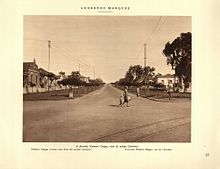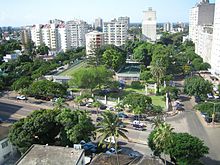Avenida Eduardo Mondlane (Maputo)
The Avenida Eduardo Mondlane is a four- to six-lane road about 3.5 kilometers long in the Mozambican capital Maputo . It crosses the entire city center of Maputo and connects the districts of Polana , Central and Alto Maé . It is named after the first chairman of the FRELIMO independence movement , Eduardo Mondlane . It is an entry and exit street in downtown Maputo.
geography
The Avenida Eduardo Mondlane begins at the intersection with the north-south axis Avenida Julius Nyerere , in the southeast part of the city, in the Polana district. From there it leads in a straight line towards the northwest. The street crosses several other major and important axes: Avenida Salvador Allende , Avenida Amílcar Cabral , Avenida Vladimir Lenine , Avenida Karl Marx and Avenida Guerra Popular . The street ends at the border with the 2nd district of Nhlamankulu on the roundabout Avenida da Zâmbia / Rua João Albasini , which is designed as a roundabout and leads to the inner-city (semi) ring road Avenida da Tansânia / Avenida Marien Nghouabi / Avenida Mao Tsé Tung or to the Avenida de Trabalho (Malanga district).
Administrative classification
Like every street in the Mozambican capital, this one also has an administrative number. The Avenida Eduardo Mondlane only runs through the first district of KaMpfumo and therefore only has the administrative number "Avenida 1.106". There is no classification in the national road network of the country.
history
The street is one of the main axes of the city and was built as part of the Joaquim José Machados urbanization plan in 1887 under the name Avenida Pinheiro Chagas and the parallel street Avenida 24 de Julho . With the increasing urbanization of the city towards the west (spin-off of the port towards Matola ) and east (foundation of the districts Polana and Sommerschield ), the importance of the street grew. The street was initially named after the Portuguese scholar and writer Manuel Joaquim Pinheiro Chagas .
In the course of Mozambique's independence, numerous streets in the city lost their original names, including this one. Since 1975 she has been named Eduardo Mondlanes, the first chairman of the Mozambican independence movement, who was murdered in 1969.
With the economic boom after the end of the civil war in 1992, the road also gained in importance due to more traffic. In the meantime, traffic jams on the road are increasing, especially at rush hour. However, the increasing commercialization of the street is clearer. It is now considered to be the largest (and longest) shopping street in the city. Especially at the western end there are numerous informal roadside stalls.
In order to noticeably relieve the traffic, the city administration of Maputo is planning to build a rapid bus system (" Bus Rapid Transit ") between the bus station at the Natural History Museum via Avenida Eduardo Mondlane to the north of the city ; This includes, among other things, structurally separated bus lanes as well as own, covered bus stops. On Avenida Eduardo Mondlane, this would affect the section between Avenida Guerra Popular and Avenida Tomás Nduda / Avenida Mártires do Machava.
Important buildings
Polana
At the eastern beginning of Avenida Eduardo Mondlane , in the Polana district, there are numerous office and commercial buildings as well as embassies and high commissions . The Mozambique for the foreign policy-relevant embassy of Portugal and the High Commission of South Africa are located directly at the intersection with Avenida Julius Nyerere . In the vicinity of this, various ministries and foreign organizations have settled in the side streets.
Between the intersection with Avenida Tomás Nduda and Avenida Salvador Allende is the 16-hectare area of the city's central hospital ( Hospital Central de MaputoI ), where the medical faculty of the Universidade Eduardo Mondlane is also located. Medical facilities have been located there since the beginning of the 20th century. Since the 1930s, after various architectural competitions, the colonial administration built the hospital under the name Hospital Miguel Bombarda (named after Miguel Bombarda ), designed by António Rosas . In the 1960s, the building received various satellite buildings designed by Francisco de Assis and Luiz de Vasconcelos . A small villa originally belonged to the hospital, which was intended as a lounge and small canteen for doctors. This building has housed a luxury restaurant with an attached nightclub since the mid-2000s. It bears the name of the year the building was built ("Restaurante 1908").
The health complex also includes the Ministry of Health ( Ministério da Saúde ), which is also at the intersection of Avenida Eduardo Mondlane and Avenida Salvador Allende , and stands out for its modern facade from the 1970s. Francisco de Assis designed the building, inaugurated in 1971, which already housed the health administration during colonial times.
Central
In the further course of the street towards the west, the six-lane street is dominated by large residential buildings from the 1950s to 1970s with many shops. At the intersection with Avenida Amílcar Cabral is the seat of the state energy supplier Electricidade de Moçambique (EDM).
Furthermore, the particularly striking mosque Masjid Taqwa (see also Taqwā ) is located in this section . There is also the social center of the first division soccer club Liga Muçulmana and a soccer field.
At the junction with Avenida Karl Marx is one of the oldest cemeteries in Maputo, the Cemitério de São Francisco Xavier , also known as the "Cemitério da Ronil". Erected around 1886 outside the city, it gradually grew around the cemetery. Among other things, people of Christian as well as Jewish and Muslim faith were buried there. Burials have not been allowed in the cemetery since 1957, but burials were carried out there until 1974. Due to the lack of care and maintenance, the place serves as a hostel for people without shelter. In 2013, much of the cemetery burned down.
Alto-Maé

In the last stretch in the Alto-Maé district, residential buildings with single-storey shops and particularly informal trade also dominate the street. The street market of Avenida da Guerra Popular extends to the intersection.
At the intersection with Rua Rainha Dona Leonor is the Cinema Charlot , built in 1963 and designed by Marco Miranda Guedes . Along with the Cine África and the Teatro Gil Vicente , it was one of the most famous cinemas in the city. The cinema has not been used since a fire in September 2013.

At the intersection with Avenida da Zâmbia is a statue of the first chairman of the Mozambican independence movement ( FRELIMO ), Eduardo Mondlane . Many demonstrations and protests start at the statue and then continue to the city center. The term "a estátua" (German "the statue" for the statue Mondlane) has developed into a pars pro toto for the area at the western end of Avenida Eduardo Mondlane.
At the end of the road at the junction with the Tanzania / Rua João Albasini / Avenida do Trabalho Avenida da a major transport hub with numerous stops of public buses, semi-public minibuses and Txopelas ( auto rickshaws ).
Web links
Individual evidence
- ↑ Olga Maria Lopes Serrão Iglés Neves: O movimento associativo africano em Moçambique, Tradição e Luta (1926-1962). Faculdade de Ciências Sociais e Humanas, Universidade Nova de Lisboa, July 2008, p. 85 , accessed on October 22, 2014 (Portuguese, dissertation in history).
- ↑ Nomes de bairros, de praças e de ruas de Lourenço Marques e de Maputo. (No longer available online.) In: Maputo 120 anos. 2005, archived from the original on June 11, 2012 ; Retrieved October 15, 2014 (Portuguese). Info: The archive link was inserted automatically and has not yet been checked. Please check the original and archive link according to the instructions and then remove this notice.
- ↑ Xadreque Gomes: Dossier Eduardo Mondlane - Comércio dominant Avenida Eduardo Mondlane. In: A Verdade. January 30, 2009, accessed December 13, 2014 (Portuguese).
- ↑ Construção do BRT Inicia próximo ano em Maputo. In: A Verdade. October 2, 2014, accessed March 27, 2015 (Portuguese).
- ↑ Maputo inicia criação de vias para autocarros. In: Jornal Notícias. July 14, 2014, accessed March 27, 2015 (Portuguese).
- ^ Tiago Lourenço: Hospital Miguel Bombarda / Hospital Central de Maputo. In: Sistema de Informação para o Património Arquitectónico (SIPA). 2011, accessed April 6, 2015 (Portuguese).
- ^ Edifício do Restaurante 1908. In: Sistema de Informação para o Património Arquitectónico (SIPA). 2011, accessed April 6, 2015 (Portuguese).
- ^ Tiago Lourenço: Edifício da Direção Provincial de Saúde / Edifício do Ministério da Saúde. In: Sistema de Informação para o Património Arquitectónico (SIPA). 2011, accessed April 6, 2015 (Portuguese).
- ^ Centro Social da Liga Muçulmana. In: www.halalmoz.com. Comissão Halal de Moçambique, accessed April 6, 2015 (Portuguese, undated).
- ↑ O monumental saque dos mortos e da história (1). In: Diário de um Sociólogo. December 22, 2007, accessed April 6, 2015 (Portuguese).
- ↑ Cemitério São Francisco Xavier abriga vivos. MMO Notícias, March 12, 2015, accessed April 6, 2015 (Portuguese).
- ↑ Incendio deflagra cemitério São Francisco Xavier em Maputo. In: A Verdade. July 24, 2014, accessed April 6, 2015 (Portuguese).
- ↑ Era uma vez Cinema Charlot. In: Jornal Notícias. September 17, 2013, accessed April 6, 2015 (Portuguese).
- ↑ Adérito Caldeira: Incendio consome cinema Charlot em Maputo. In: A Verdade. September 16, 2013, accessed April 6, 2015 (Portuguese).
- ↑ A praça dos “nossos” heróis. In: A Verdade. 2013, accessed October 27, 2015 (Portuguese).



